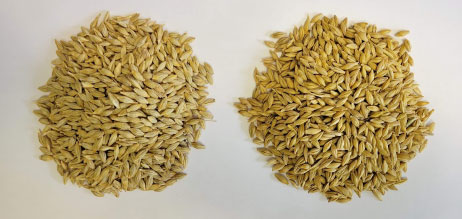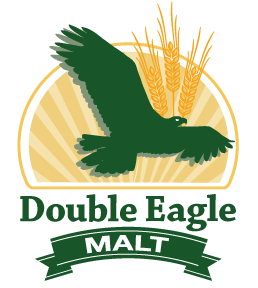2023 Malting Barley Harvest Report
August 2023
For the past 9 years, Double Eagle has contracted principally
with 4 family farmers to grow our grains. Because malting
barley is a finicky crop to get right and we have such
variable weather and growing conditions in Pennsylvania, we
distribute our commitments to different regional microclimates
to share the bounty and also to reduce risk. We will
occasionally also purchase grain from other partners and spot
growers if it meets our specs and the opportunities are
available.
We are privileged to work with these core family farm
partners:

This year, our spring was exceptionally dry and hot which
usually means a high quality grain but a low yield. What came
off the field in late June looks stunningly beautiful with
bright, plump kernels. And for the most part, yields were
surprisingly good. We typically forecast 80 bushels per acre
for planning purposes, but the Musser brothers reported 135
bu/ac this year. Grain samples from all four plots have been
sent to our ASBC lab for analysis, so we’ll see results in a
couple weeks, but we have high expectations for exceptional
malting stock.
In contrast to the local barley harvest, the USDA National
Agricultural Statistics Service (NASS) just released their
July 12, 2023 Crop Production Report. Total US production is
forecast at 177 million bushels and based on conditions as of
July 1, the average yield for the United States is forecast at
70.1 bushels per acre, a far cry from our extraordinary winter
variety yields in humble Lancaster County PA. We have a lot to
be proud of with our agricultural heritage.
Because our Mid-Atlantic climate is more conducive to winter
grains, our farmers can get the barley off the field in late
June, in time to plant a second crop of another commodity,
usually soybeans. So they not only see bigger yields from
their barley harvests than western farms, but they can also
double-crop in the same season.
Some background on barley variety
Until very recently, all of the malting barley in the US has
been grown in the northwestern states where spring varieties
are planted. Thus, US small grain breeders have a financial
interest to focus their efforts on improving spring grains
rather than attempting to develop winter varieties. With the
rise of craft malthouses like ours in the east there has been
renewed interest in developing winter varieties because it is
very difficult to grow spring barley here for a variety of
reasons. So, we have relied upon European winter breeds for
our local farms; however, finding a variety well suited to our
climate has been challenging.
For the past 5 or 6 years, that variety has been Violetta.
Next year, however, we are looking forward to a homegrown
winter barley variety called Avalon that came out of the
Virginia Tech small grains breeding program. This new variety has been bred for our climate and growing
conditions and looks very promising, from both an agronomic
and malting quality perspective. We’ll plant Avalon in fall
2023, harvest it in late June 2024, then store it until
January 2025 when we expect it to break dormancy for malting.
So, yeah, the planning to production cycle involves a long
horizon and a lot of patience.
Potential Bonus Variety
One of Dustin Musser’s neighbors grew a 6-row malting barley
variety for cattle feed, and he gave us a sample to send out
for testing. It’s a European variety called Faro (shown on the
right in the photo below next to Violetta) that is new to us
so we’re excited to see what the lab tells us about it. For
brewers inclined to use 6-row malt for certain Belgian and
other Euro-styles, this could be very interesting.

Keep an eye out for another post on malting barley quality
once we get the grain analysis back from the lab.
For more details or information on farm sources of interest to
you, contact
alan@doubleeaglemalt.com.
|
|










